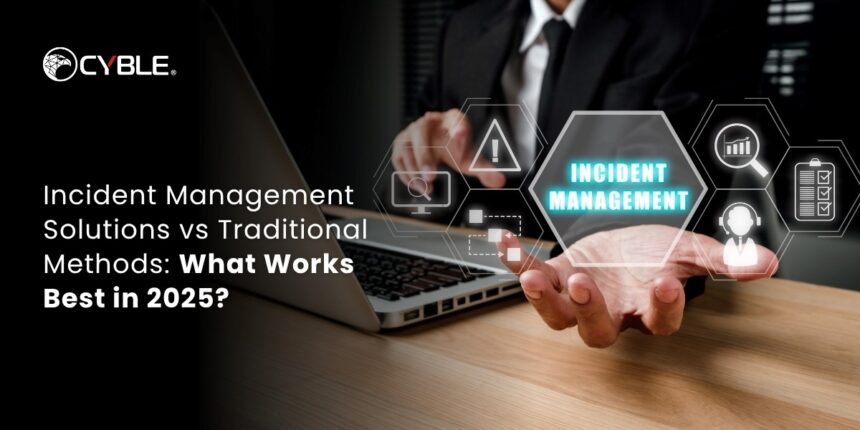Remember the days when managing an incident meant scribbling notes on paper, raising tickets, calling around the team, and hoping someone could fix it before things got worse? Fast forward to 2025, and that old-school approach just doesn’t hold up anymore.
Today, businesses are dealing with more data, more users, and more potential failure points than ever before. That means the stakes are higher, and the pressure to respond quickly is real. So, the question isn’t whether you need an incident management process. It’s whether your current approach is keeping up.
In this article, we will take a closer look at how incident management solutions have evolved and why traditional incident management methods are losing ground. Moreover, we will understand what makes modern incident response tools essential in 2025.
The Issue with Traditional Incident Response Methods
Traditional incident response systems have always been reactive. Which meant delay in tracking threats and greater penetration for threat actors. According to the Ponemon Institute, the average time to detect a breach is 204 days—which is nearly seven months before companies even realize they’ve been compromised. Add to this an average of another 54 days to contain the breach and you are eating up nearly a year worth of business due to pure reliance on traditional incident response mechanisms.
What’s more terrifying is that even after knowing these number, 85% of businesses still rely on manual security processes, as per the U.S. CISA.
While traditional incident management methods may seem familiar and easy to implement, they come at a cost of inconsistency, slower response times, and missed alerts.
For example, in a cybersecurity incident, manual identification and triaging might take hours. In contrast, imagine an AI-powered cybersecurity tool that initiates incident management the moment an anomaly is detected and isolates the threats in real-time.
Moreover, relying on human memory or outdated spreadsheets for tracking incidents puts the organization at significant risk.
What Makes Modern Incident Response Tools Different?
The big shift in incident management in 2025 lies in technology. Modern incident response tools are built with scalability, AI, automation, and integration in mind. Instead of waiting for something to break and react, they monitor, detect anomalies, correlate events, and trigger responses before they happen and at times even deploy resolution processes autonomously.
Here’s where the difference between manual and automated incident response becomes clear:
- Traditional: Relies on people to interpret and respond to incidents.
- Modern: Uses AI and machine learning to detect, prioritize, and respond in seconds.
These next-gen tools don’t just make life easier for your IT teams; they actively reduce business risk and downtime, invariably increasing your returns on investment (ROI).
According to IBM, companies using AI-powered security cut their breach detection time by half. Ponemon’s analysis supports these claims which says businesses with automated detection systems contain threats 40% faster. And what does this translate into? AI-driven security automation helps save companies $2.22 million per breach by cutting response times and improving containment.
Key Advantages of Modern Incident Management Systems
- Speed and Accuracy: Automation reduces human error and drastically cuts resolution time.
- Scalability: Handle hundreds of incidents without additional manpower.
- AI in Incident Response: Detects patterns, flags anomalies, and recommends solutions in real-time.
- Consistency: Every incident is handled using predefined, optimized workflows.
- Compliance: Digital logs and audit trails ensure adherence to security and industry standards.
These are some of the many advantages of modern incident management systems that make them a compelling alternative.
The Rise of AI in Incident Response
AI has moved from buzzword to baseline in incident management in 2025. Today, AI engines don’t just assist; they lead. They sift through logs, correlate signals across platforms, and flag anomalies that would take humans hours, if not days, to notice.
This is a game-changer for automated incident management. It allows businesses to transition from reactive firefighting to proactive prevention and defence, one of the most vital incident response best practices 2025 has to offer.
Metrics, Analytics, and Continuous Learning
One underrated feature of modern incident response tools is their ability to learn and improve. Systems today analyse previous incidents to improve future responses. They show what worked, what didn’t, and what needs optimization.
This ties directly into incident response best practices 2025, where data-driven decision-making is key to building long-term resilience.
Modern organizations can no longer afford disjointed and reactive incident handling. Cyble’s Incident Management module addresses this by consolidating alerts into actionable incidents, streamlining workflows, and minimizing resolution delays.
Choosing What Works Best in 2025
If you are weighing your options between traditional incident management methods and modern incident response tools, consider these:
- Complexity of Your Environment: More systems mean more potential failure points.
- Team Size: Smaller teams benefit greatly from automated incident management.
- Compliance Needs: Are audit trails and digital records required?
- Response Time Expectations: Manual processes rarely match the pace of today’s incidents.
The shift is happening across sectors, from IT to manufacturing, from finance to healthcare. Companies that resist digital transformation are likely to face not just higher risks but steeper recovery costs.
Conclusion
Incident management in 2025 demands more than good intentions. It requires modern tools, agile teams, and automated workflows. Sticking with outdated methods might feel comfortable, but it’s increasingly becoming a liability.
The future of incident response lies in systems that can anticipate, learn, and act, in real-time. By embracing incident management solutions, enterprises can not only protect their operations but also build trust with customers, regulators, and stakeholders.
If there’s one takeaway from this comparison, it’s this: In 2025, automated incident management isn’t optional. It’s the new normal.


